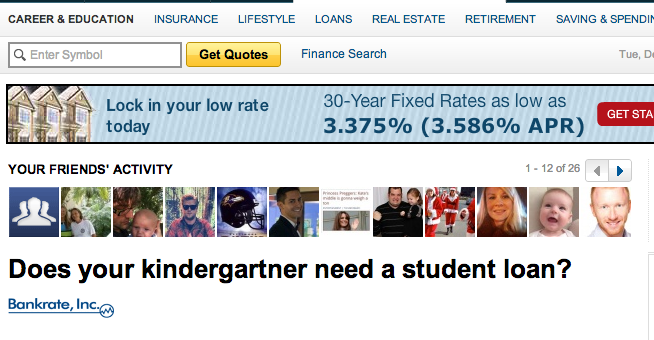Does Your Kindergartner Need a Student Loan?
Published August 28, 2012 on Yahoo! Finance
The rising cost of college has gained national attention, but parents footing private school bills for younger students are feeling the price squeeze as well. According to the National Association of Independent Schools, or NAIS, a nonprofit representing 1,400 independent schools and associations in the U.S., the median tuition at private elementary, middle and high schools has risen 35 percent over the past 10 years when adjusted for inflation. To meet the higher demands, an increasing number of companies are offering loans for private school parents. However, these loans come with catches.
Are loans even necessary?
Even though prices are climbing at private secondary schools, so is financial aid. While the median tuition for K-12 private day school students is $19,820 (for those in boarding school, it jumps to $45,200), many schools offer need- and merit-based aid packages that could make a loan unnecessary. The NAIS reports that the median financial aid package for a private day school student is $10,340. For boarding school students, that figure increases to $21,389.
If loans are the only option after financial aid is exhausted, be careful not to borrow too much too early, says Kimberly Foss, a Certified Financial Planner and founder of Empyrion Wealth Management in Roseville, Calif.
“If (a family is) going to put their child into private school, especially K-8, they should be able to afford 60 (percent) to 70 percent of that,” she says.
Foss adds that the debt rules are a bit more lenient for parents of high school and preparatory school students who only have a few years of private school financing ahead of them because they won’t need to borrow as much or for an extended period of time. But parents still should be able to foot most of the bill through savings or financial aid before looking to take out a loan.
How K-12 loans are different from college loans
School loans for grades K-12 play by a different set of rules than college loans offered through the federal government, says Kristen Power, northeast regional director for NAIS. Federal college loans come with a fixed interest rate and a standard 10-year repayment period. Loans parents and students need for private schools frequently come with variable interest rates and shorter repayment periods.
Power says that in the last five years, it’s become harder to get a substantial loan for private K-12 education because of tighter credit requirements and lower loan limits. “Whereas at one point in early 2000s to 2008, lenders were allowing families to take out up to $80,000 on an annual loan limit … now the loan limits are about $30,000 annually,” she says.
Private loans for secondary education may also not get the same protections for borrowers who hit financial hardship. For federal student loans, the government offers deferment and forbearance options, extended repayment plans, and the ability to cap monthly payments. Private loans for students in kindergarten through high school may not come with these safety nets.
Think twice and plan ahead
If your funds just don’t allow for private school but it’s the education you’d like for your child, you might want to look for another loan alternative before going to a traditional lender. Borrowing from relatives or using home equity lines of credit could be potential options. However, you’ll still be borrowing, and the money will need to be paid back at some point.
If those aren’t doable options, parents can increase their chances of getting better interest rates on a private student loan by raising their credit score through paying off debt and outstanding delinquencies ahead of time, says Jim Donovan, co-founder and chief operating officer of Your Tuition Solution, a company in Southborough, Mass., that offers fixed-rate loans for families of private school students in grades K-12.
Donovan says families should carefully evaluate what they can afford and whether they’ll be taking on the loan as a temporary measure to get over a specific financial hurdle or as a long-term plan for financing education.
“Folks just have to be realistic about (whether) they (can) afford this,” he says. “If someone is looking at a K-8 program that’s going to cost them $8,000 or $10,000 or $15,000 a year … if they don’t have a game plan ahead of time, if they’re going to be relying strictly on loans and credit cards to pay for that, you’ve got to question: Is it really worth it?”






